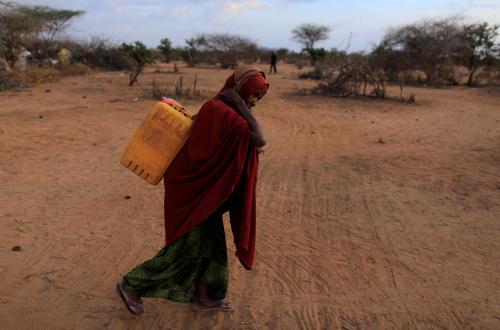Earlier this month, the United Nations released its annual Sustainable Development Goals Report, which measures the progress of and identifies gaps in the implementation of all 17 Sustainable Development Goals (SDGs). The report notes progress in some areas, but warns that the global commitment to the SDGs has not yet been sufficient, and that the most vulnerable people and countries are at risk of being left behind. The report also notes that climate change and increasing inequality within and across countries are undermining progress and threaten to reverse many of the gains made over recent decades.
As Figure 1 shows, while the share of the world’s population living in extreme poverty has declined dramatically since 1990, this progress has slowed in recent years. Extreme poverty remains high in low-income countries and countries affected by conflict, particularly in sub-Saharan Africa, where 413 million people still live on less than $1.90 a day. The report states that, without significant shifts in policy and increased global commitment, the share of extreme poverty will likely remain in the double digits in Africa in 2030.
Figure 1: Global proportion of people living below $1.90 a day, 1990-2015 and projection to 2030 (percentage)
Source: Sustainable Development Goals Report 2019
Despite these challenges, Africa has made significant progress in other areas. For example, as Figure 2 shows, the proportion of children under five years who are stunted—defined as inadequate height for age and a symptom of chronic undernutrition—declined from 41 percent in 2000 to 32 percent in 2018. And as Figure 3 shows, the child mortality rate in Africa dropped dramatically between 2000 to 2017: The mortality rate of children under five was halved in this period, and the neonatal mortality rate fell from around 40 deaths per 1,000 live births to less than 30.
Figure 2: Proportion of children under five years who are stunted, 2000 and 2018 (percentage)
Source: Sustainable Development Goals Report 2019
Figure 3: Under-five and neonatal mortality rate, 2000-2017 (deaths per 1,000 live births)
Source: Sustainable Development Goals Report 2019
Overall, sub-Saharan Africa’s progress on the SDGs is encouraging, but needs to accelerate significantly in order to meet targets by 2030. The report emphasizes that the SDGs are global challenges that require global solutions; strong international and regional cooperation is needed to ensure that all countries across Africa and the world have the means to achieve the SDGs.
For more on progress toward the SDGs in Africa, see the recent post, “Africa and the Sustainable Development Goals: A long way to go,” by Belay Begashaw.








Commentary
Figures of the week: Africa’s progress on the Sustainable Development Goals
July 31, 2019